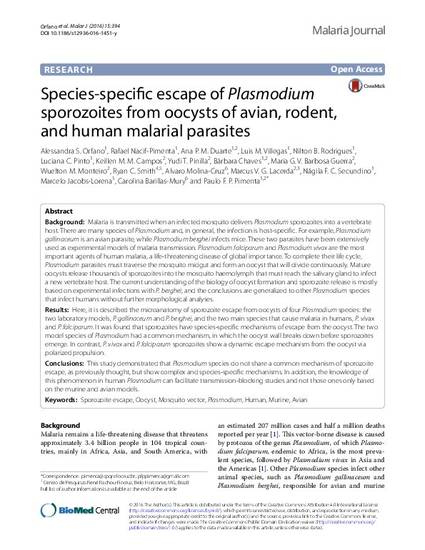
Background
Malaria is transmitted when an infected mosquito delivers Plasmodium sporozoites into a vertebrate host. There are many species of Plasmodium and, in general, the infection is host-specific. For example, Plasmodium gallinaceum is an avian parasite, while Plasmodium berghei infects mice. These two parasites have been extensively used as experimental models of malaria transmission. Plasmodium falciparum and Plasmodium vivax are the most important agents of human malaria, a life-threatening disease of global importance. To complete their life cycle, Plasmodium parasites must traverse the mosquito midgut and form an oocyst that will divide continuously. Mature oocysts release thousands of sporozoites into the mosquito haemolymph that must reach the salivary gland to infect a new vertebrate host. The current understanding of the biology of oocyst formation and sporozoite release is mostly based on experimental infections with P. berghei, and the conclusions are generalized to other Plasmodium species that infect humans without further morphological analyses. Results
Here, it is described the microanatomy of sporozoite escape from oocysts of four Plasmodium species: the two laboratory models, P. gallinaceum and P. berghei, and the two main species that cause malaria in humans, P. vivax and P. falciparum. It was found that sporozoites have species-specific mechanisms of escape from the oocyst. The two model species of Plasmodium had a common mechanism, in which the oocyst wall breaks down before sporozoites emerge. In contrast, P. vivax and P. falciparum sporozoites show a dynamic escape mechanism from the oocyst via polarized propulsion. Conclusions
This study demonstrated that Plasmodium species do not share a common mechanism of sporozoite escape, as previously thought, but show complex and species-specific mechanisms. In addition, the knowledge of this phenomenon in human Plasmodium can facilitate transmission-blocking studies and not those ones only based on the murine and avian models.
Available at: http://works.bepress.com/ryan_smith1/14/

Published as Orfano, Alessandra S., Rafael Nacif-Pimenta, Ana PM Duarte, Luis M. Villegas, Nilton B. Rodrigues, Luciana C. Pinto, Keillen MM Campos et al. "Species-specific escape of Plasmodium sporozoites from oocysts of avian, rodent, and human malarial parasites." Malaria journal 15, no. 1 (2016): 394. doi: 10.1186/s12936-016-1451-y